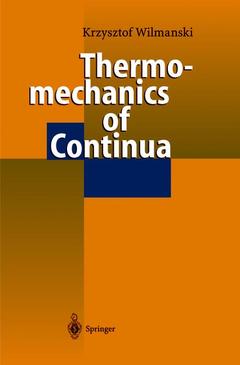Thermomechanics of Continua, Softcover reprint of the original 1st ed. 1998
Langue : Français
Auteur : Wilmanski Krzysztof

The notion of continuum thermodynamics, adopted in this book, is primarily understood as a strategy for development of continuous models of various physical systems. The examples of such a strategy presented in the book have both the classical character (e. g. thermoelastic materials, viscous fluids, mixtures) and the extended one (ideal gases, Maxwellian fluids, thermoviscoelastic solids etc. ). The latter has been limited intentionally to non-relativistic models; many important relativistic applications of the true extended thermodynamics will not be considered but can be found in the other sources. The notion of extended thermodynamics is also adopted in a less strict sense than suggested by the founders. For instance, in some cases we allow the constitutive dependence not only on the fields themselves but also on some derivatives. In this way, the new thermodynamical models may have some features of the usual nonequilibrium models and some of those of the extended models. This deviation from the strategy of extended thermodynamics is motivated by practical aspects; frequently the technical considerations of extended thermodynamics are so involved that one can no longer see important physical properties of the systems. This book has a different form from that usually found in books on continuum mechanics and continuum thermodynamics. The presentation of the formal structure of continuum thermodynamics is not always as rigorous as a mathematician might anticipate and the choice of physical subjects is too disperse to make a physicist happy.
1 Introduction.- 1.1 Preliminary Remarks.- 1.2 Chains of Mass Points.- 1.3 Contents of the Book.- 2 Geometry.- 2.1 Reference and Current Configurations.- Remark 2.1. On Non-material Vectors.- Remark 2.2. On Non-integrable Deformation Gradients.- 2.2 Polar Decomposition of the Deformation Gradient.- Example 2.1. Deformation of a Prism in the Homogeneous Extension.- Example 2.2. Deformation of a Prism in the Simple Shearing.- Example 2.3. A Polar Decomposition and Elastic-plastic Deformation.- 2.3 Some Other Measures of Deformation.- Remark 2.3. On Universal Solutions — Part.- 3 Kinematics.- 3.1 Description of Motion.- 3.2 Time Changes of Some Geometric Objects.- 3.3 Change of the Reference Frame.- Remark 3.1. On Objective Time Derivatives.- 4 Balance Equations.- 4.1 Preliminary Remarks.- 4.2 Global Balance Equations.- 4.3 Local Balance Equations.- 4.4 Local Conservation Laws.- 4.5 Spatial Form of Balance Equations.- 4.6 Spatial Form of the Local Conservation Laws.- Example 4.1. Stresses in the Homogeneous Extension of a Prism.- 4.7 Conservation Laws in a Non-Inertial Frame of Reference.- 5 Structure of Field Equations.- 5.1 Introductory Remarks.- Example 5.1. Isothermal Processes in a Linearly Elastic Rod.- Example 5.2. The Heat Conducting Linearly Elastic Rod.- 5.2 Isotropic Functions.- Example 5.3. Euler; the Basic Invariants and Generators for m Vector Variables.- Example 5.4. The Basic Invariants and Generators for one Vector and one Symmetric Tensor Variable.- Example 5.5. The Linearization for one Vector and one Symmetric Tensor Variable.- 5.3 Galilean Invariance of Field Equations.- Example 5.6. The Field Equations for Thirteen Fields.- Remark 5.1. On the Moments of the Boltzmann Equation.- Remark 5.2. On the Material Objectivity.- 6 Entropy Principle.- 6.1 Preliminary Remarks.- 6.2 Entropy Inequality.- Example 6.1. Eulerian Heat Conducting Fluid.- Example 6.2. Thermo-Viscoelastic Rod.- 6.3 Hyperbolicity of Field Equations.- 6.4 Thermoelastic Materials with Mechanical Constraints.- Example 6.3. Non-linear Thermoelastic Materials.- Example 6.4. Incompressible Materials.- Example 6.5. Inextensible Materials.- Example 6.6. Rigid Bodies.- Remark 6.1. On the Universal Solutions — Part II.- 6.5 Solid Interfaces.- 7 Ideal Gase.- 7.1 Introduction.- 7.2 Galilean Invariance; Material Frame Indifference.- 7.3 Entropy Inequality.- 7.4 Hyperbolicity.- 8 Maxwellian Fluids; Viscoelastic Solids Part 1: Maxwellian Fluids.- 8.1 Background of the Models of Maxwellian Fluids.- 8.1.1 Example 8.1. One-dimensional NthGrade Models.- 8.2 Constitutive Relations for a Non-Conducting Non-Newtonian Fluid; Field Equations.- 8.3 Entropy Principle.- 8.4 Thermodynamical Stability; Shear Pulses.- 8.5 Incompressibility; 2nd Grade Fluids.- 8.6 Field Equations in the Lagrangian Description.- 8.7 Second-Order Model of Isotropic Materials.- 8.8 Linear Viscoelastic Solids.- 9 Second Sound.- 9.1 Preliminary Remarks.- Remark 9.1. On the Moments of the Boltzmann-Peierls Equation.- 9.2 Thermodynamical Model of the Phonon Gas.- 9.3 Four-Field Model.- 9.4 Thermal Waves.- Example 9.1. Characteristic Speeds for the Four-Field Model.- 10 Some Multicomponent System.- 10.1 Introduction.- 10.2 Lagrangian Description.- Remark 10.1. On the Measurability of the Temperature.- Remark 10.2. On the Natural Mechanical Boundary Conditions.- 10.3 Balance Equation for Porosity.- 10.4 Second Law of Thermodynamics for a Thermoelastic Skeleton and Ideal Fluid Components.- 10.5 Small Deviations from the Thermodynamical Equilibrium.- 10.6 Propagation of Plane Waves of Small Amplitude.- 10.7 Final Remarks.- Appendix A: Thermostatics.- Appendix B: Curvilinear Coordinates.- Appendix C: Hyperbolic Systems of PDE.- C.l. Preliminaries.- C.2. Single Equation of Two Independent Variables.- C.3. Set of Equations with Two Independent Variables.- C.4. Time of Existence of Classical Solutions.- C.5. Systems with Many Independent Variables.- References.
The book is an unusual, comprehensive review of modern nonlinear thermodynamics giving also numerous examples for the practitioners.
Date de parution : 10-2012
Ouvrage de 276 p.
15.5x23.5 cm
Disponible chez l'éditeur (délai d'approvisionnement : 15 jours).
Prix indicatif 52,74 €
Ajouter au panierThème de Thermomechanics of Continua :
© 2024 LAVOISIER S.A.S.


